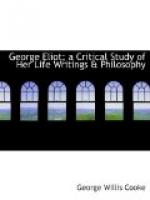I saw my aunt twice after this. Once I spent a day and a night with my father in the Wirksworth cottage, sleeping with my aunt, I remember. Our interview was less interesting than in the former time: I think I was less simply devoted to religious ideas. And once again she came with my uncle to see me—when father and I were living at Foleshill; then there was some pain, for I had given up the form of Christian belief, and was in a crude state of free-thinking. She stayed about three or four days, I think. This is all I remember distinctly, as matter I could write down, of my dear aunt, whom I really loved. You see how she suggested Dinah; but it is not possible you should see as I do how her entire individuality differed from Dinah’s. How curious it seems to me that people should think Dinah’s sermon, prayers and speeches were copied—when they were written with hot tears as they surged up in my own mind!
As to my indebtedness to facts of locale, and personal history of a small kind connected with Staffordshire and Derbyshire—you may imagine of what kind that is when I tell you that I never remained in either of those counties more than a few days together, and of only two such visits have I more than a shadowy, interrupted recollection. The details which I knew as facts and have made use of for my picture were gathered from such imperfect allusion and narrative as I heard from my father in his occasional talk about old times.
As to my aunt’s children or grandchildren saying, if they did say, that Dinah is a good portrait of my aunt—that is simply the vague, easily satisfied notion imperfectly instructed people always have of portraits. It is not surprising that simple men and women without pretension to enlightened discrimination should think a generic resemblance constitutes a portrait, when we see the great public so accustomed to be delighted with mis-representations of life and character, which they accept as representations, that they are scandalized when art makes a nearer approach to the truth.
Perhaps I am doing a superfluous thing in writing all this to you, but I am prompted to do it by the feeling that in future years Adam Bede and all that concerns it may have become a dim portion of the past, and I may not be able to recall so much of the truth as I have now told you.
Once more, thanks, dear Sara. Ever your loving
MARIAN.
When, in 1876, a book was published to show the identity of Dinah Morris and Elizabeth Evans, George Eliot wrote to the author to protest against such a conclusion. She said to him that the one was not intended to represent the other, and that any identification of the two would be protested against as not only false in fact and tending to perpetuate false notions about art, but also as a gross breach of social decorum. Yet these declarations concerning Elizabeth Evans have been repeated, and to them has been added the assertion




